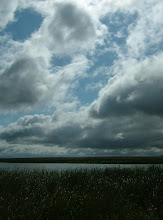 The 'flower' bud is always at the bottom of the hanging cluster and yet, you never never see a banana cluster there at the end, which you would think would happen when that last end flower opened and got pollinated and turned into bananas. Well, on this visit to the Mitchel Conservatory, otherwise known as the 'domes', there was another plant nearby, a small relative of the edible banana, that told the story. I could examine its smaller flowers up close and figure some of it out! The 'flower' at the end is not really one flower at all, but a series of flowers layered between single 'petals'. The maroon 'petal' opens up to reveal a series of yellow-orange tube-like flowers that lie flat along the next 'petal'. If that series of flowers is pollinated, it grows to be a banana cluster. If it is not pollinated in time, the petal and flowers fall off, and the next one matures and opens. This failure of a set of flowers to pollinate, because whatever insect that pollinates them is not available, is what leaves the gaps between banana clusters. The ones at the top of the hanging assembly are the oldest and the closest to being ripe, so one would harvest from the top down.
The 'flower' bud is always at the bottom of the hanging cluster and yet, you never never see a banana cluster there at the end, which you would think would happen when that last end flower opened and got pollinated and turned into bananas. Well, on this visit to the Mitchel Conservatory, otherwise known as the 'domes', there was another plant nearby, a small relative of the edible banana, that told the story. I could examine its smaller flowers up close and figure some of it out! The 'flower' at the end is not really one flower at all, but a series of flowers layered between single 'petals'. The maroon 'petal' opens up to reveal a series of yellow-orange tube-like flowers that lie flat along the next 'petal'. If that series of flowers is pollinated, it grows to be a banana cluster. If it is not pollinated in time, the petal and flowers fall off, and the next one matures and opens. This failure of a set of flowers to pollinate, because whatever insect that pollinates them is not available, is what leaves the gaps between banana clusters. The ones at the top of the hanging assembly are the oldest and the closest to being ripe, so one would harvest from the top down.I still have questions. For how long does that 'flower' continue to make new flowers and new petals from the inside out? What are the pollinators, in greenhouses such as these and in the real world?

No comments:
Post a Comment